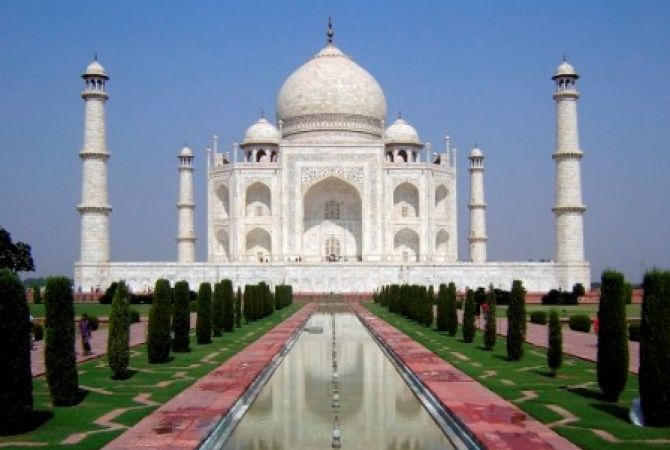India declares November 26 as "Constitution Day"
 15:09, 25 November 2015
15:09, 25 November 2015YEREVAN, NOVEMBER 25, ARMENPRESS. As a tribute to Dr. B.R. Ambedkar, author of Independent India’s Constitution, the Government of India has declared November 26 as the ‘Constitution Day’ and this date will be officially celebrated in the country and abroad.
As “Armenpress” was informed by Embassy of India in Armenia, on November 26 1949, the Constitution of India was adopted by the Constituent Assembly and it came into force on 26 January in 1950. India, also known as ‘Bharat’, is a Union of States. Dr. Ambedkar was invited by the first independent government of India led by Late Jawaharlal Nehru to serve as the first law minister. He was appointed as the Chairman of the Constitution Drafting Committee. Hence Dr. Ambedkar is considered as the Chief Architect of the Indian Constitution. The ever lasting contribution of Dr. Ambedkar towards the Indian constitution was to constitute the country as an independent, socialist oriented, secular, autonomous republic which can secure Indian citizens by justice, equality, liberty and unity.
The preamble of the Constitution says “We, the people of India, having solemnly resolved to constitute India into a Sovereign Socialist Secular Democratic Republic and to secure to all its citizens: JUSTICE, social, economic and political; LIBERTY of thought, expression, belief, faith and worship; EQUALITY of status and of opportunity ; and to promote among them all FRATERNITY assuring the dignity of the individual and the [unity and integrity of the Nation]; IN OUR CONSTITUENT ASSEMBLY this twenty-sixth day of November, 1949, do HEREBY ADOPT, ENACT AND GIVE TO OURSELVES THIS CONSTITUTION.”
The Constitution provides for a Parliamentary form of government which is federal in structure with certain unitary features. The constitutional head of the Executive of the Union is the President. As per Article 79 of the Constitution of India, the council of the Parliament of the Union consists of the President and two Houses known as the Council of States (Rajya Sabha) and the House of the People (Lok Sabha). Article 74(1) of the Constitution provides Council of Ministers with the Prime Minister as its head to assist and advise the President who shall exercise his/her functions in accordance to the advice. The executive authority is thus vested with the Council of Ministers with the Prime Minister as its head.
When the constitution of India was adopted, the citizens of India were entered into a new constitutional, scientific, self-governing and modern India with peace, poise and progress. The constitution of India is very unique in the world and took around 2 years, 11 months and 17 days for drafting and for adoption by the Constituent Assembly.
Some facts about India’s Constitution:
• The draft was submitted in November 1949. After the submission, it took three more years to complete the adoption;
• The Constitution was adopted on 26 November 1949 while it came into force on January 26, 1950 ;
• All 284 members of the first Independent India’s Constituent Assembly including 15 women members undersigned the constitutional document on 24 January 1950 ;
• Sarnath, the Lion Capital of Emperor Ashoka with the wheel of justice, bull, and horse as the national emblem of India too was adopted on the same day;
• The Constitution of India was not typed or printed but was handwritten and calligraphed in both English and Hindi languages;
• The original copies of the Constitution of India are kept in special helium-filled cases in the Library of the Parliament of India;
• Indian Constitution is known as a ‘bag of borrowings’ with concepts of liberty, equality and fraternity were taken from the French Constitution; fundamental rights were borrowed from the U.S. Constitution; Parliamentary system of government from British; the law on which the Supreme Court functions was taken from Japan; Directive principles from the Irish constitution and the idea of emergency from the German Constitution.
• It is the longest written constitution of any independent country in the world; The Indian Constitution:
• Contains 448 articles in 25 parts, 12 schedules, 5 appendices and 99 amendments (as on December 2014); the 42nd amendment makes India “a Sovereign, Secular Socialist Democratic Republic”.
• Provides not only the basic law but also provides very detailed and minute administrative provisions so as to prevent subversion of the constitution through legislative process.
• Owing to the vast size of the country and diversity of the population, the Constitution provides protection and promotion of interests of different regions and groups in the country; contains elaborate provisions for the minorities, scheduled castes and tribes etc.
• Promotes federalism in the form “Union of States.” All characteristics of a federation viz. two sets of government - national government and a number of governments of the component units (subjects), division of powers between the central government and the state governments and federal judiciary to act as the guardian of the constitution and to settle disputes between the Centre and the States are present in the Indian constitution.
• Provides for parliamentary form of government both at the Centre and in the States.
• Guarantees fundamental rights of the citizens including right to freedom, religion and constitutional remedies ; obliteration of caste system at the national level and common civil code ; official languages and voting right to women at par with men;
• Upholds secularism as India does not have any state religion and the state remains neutral between religions.
• Does not sanction double citizenship as there is only one uniformed Indian citizenship.




















